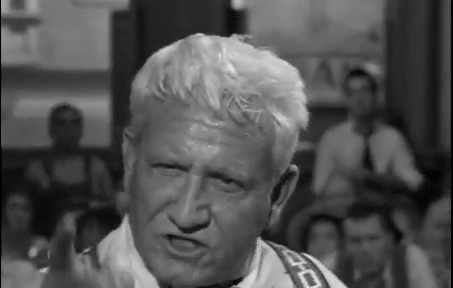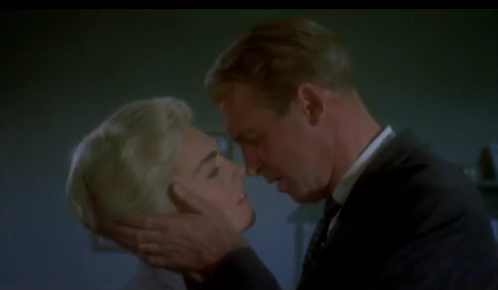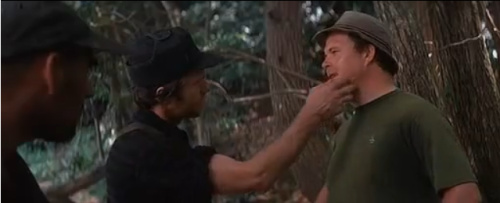
INHERIT THE WIND (1960, Kramer)
Today’s memorable shot is in honor of the premiere of my friends Aeden Babish and Kevin Fall’s new TV show, Franklin & Bash, June 1 @ 9PM/8c on TNT. Hope you’ll watch Wednesdays; Mark Paul Gosselaar and Breckin Meyer are hilarious. Congrats Kevin & Aeden!
So, speaking of judicial battles, Inherit the Wind. There’s a whole lot to be said about how Stanley Kramer could make a courtroom scene so interesting. Indeed, he did it so successfully in this film that he was soon brought right back before the bench with the star-studded Judgement at Nuremberg. Today’s shot involves Spencer Tracy in one of the most powerful moments of one of his most memorable performances.
When your action is stuck in a room, the major challenge is to make the proceedings visually dynamic, to convey, in a visual way, the tensions and excitement that’s going on dramatically, while never making your visuals a distraction. How do you tighten the screws while keeping out of the way?
Kramer Keeps it Moving
To this day there is controversy over how Kramer’s legacy will be remembered, be it as master or…otherwise. Nevertheless, Inherit The Wind stands the test of time, I think, as much for its crackling script as for its engaging camera work and direction. I’m not familiar enough with all his work to fairly chime in, so I’ll side-step the controversy and talk about just one very specific element that I know I love about his work.
In this moment below, we’re in the climax of Tracy’s pivotal oration on free speech; if he doesn’t get his way here, he’s quitting the case, or so he threatens. Kramer knows that our eyes and hearts are glued to Tracy, and a single cut would deflate what he’s building to. Not only does Kramer and his editor not cut, but the camera energetically paces with Tracy back and forth, until we stop dead, Tracy facing the camera, stepping into it as he “power-wags” his finger and goes for the jugular. (And how about the beautifully-placed, fanning crowd in the background heightening the tension throughout the whole shot?!) I even love how the framing gets a little squirrelly, cutting off Tracy’s chin – adds to the exciting energy.
Imagine how less interesting this moment would have been with a standard, static CU. I object!
This type of camera & actor blocking accentuates to the Nth degree what the actor’s delivering, and it gets me every time. The moment is at 1:29, but the whole clip is something to behold, complete with its final glimpse of one future Col. Sherman Potter.



John
Amazing clip….and forever relevant.
Carlos
They don’t make ’em like this anymore.
Anthony
Inherit the Wind was one of the movies that truly allowed me to appreciate film and, more specifically, Spencer Tracy. One of the greatest actors and artists of American history. Great choice of films to cover John.
dave cotton
I LOVE this film and I love these mini lessons in film making!
THANKS
jsbfilm
Yes, can’t go wrong with this film. Much appreciated, Dave & Anthony!
Brian Akers
Thanks again John. One of my favorite movies of all time. As you state so well, the camera work and direction behind it really allowed Spencer Tracey to command this scene. The building tension, energy, and flow, it all works so well together.
jsbfilm
Thanks, Bri! I really appreciate your taking the time to post a comment and read the blog. Glad I got to post about one of your favorites!
Ed Schweibacher
Yes, at 1:29, the gesture that “unlocks” the camera and allows us to “float” alongside Drummond is “I warn you:”. The next click of the ratcheting up is at 1:54, (“…ban books and newspapers,”) where the rotate and pan starts. I understand these are tough shots to light as well as photograph. The shot is over at 2:13 (the end of the “warning” consisting of “…and needs feeding.”), preceding “and soon, your honor” at which point Spencer Tracy, in effect, has put us back in our seat after carrying os around by the collar.
The entire sequence is the prelude and capturing of Drummond’s insidious thought experiment, and as we’re taken in by the imagery, we become unglued, until the sermon ends. It’s also important to note that, except for a few frames of Dick York’s alarm before the resigning Tracy re-enters the frame, and the plaintive query from Harry Morgan on the bench, Tracy “holds the floor”—no cuts to the prosecution. Nowadays the entire sequence would likely have been storyboarded. It’s also enjoyable when we see Drummond speaking out of the frame “to the right wing”: when he says, just after 1:00 : “Well, there are two hundred of ’em!”